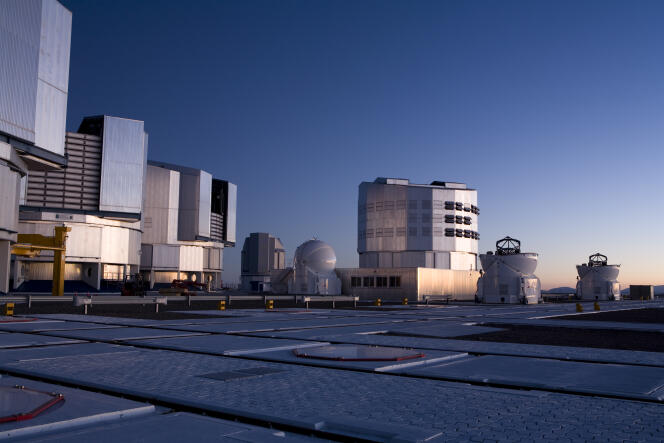


The afternoon was drawing to a close over the Atacama Desert, which was warming up in orange hues. From the summit of Cerro Paranal (2,635 meters), on the concrete platform where the Very Large Telescope (VLT) was installed a quarter century ago with its four large telescopes (8.2 meters in diameter) and four auxiliary telescopes (1.8 meters), the gaze that plunges towards the Chilean coast, some 15 kilometers away, encountered a sea of clouds hiding the Pacific. It's easy to understand why the European Southern Observatory (ESO) chose this location for the VLT, above the cloud ceiling, on a site where 90% to 95% of the year's nights are suitable for observation, with dry, stable, pure skies.
There's not a town in sight and, on moonless nights, you can barely make out the diffused halo of Antofagasta, the region's capital. Two vultures, taking advantage of the wind blowing up the slope, floated lazily along the still-closed domes protecting the telescopes. The four large machines bear two names. The first is technical: Unit Telescope (UT) 1, 2, 3 and 4. The second, more poetic, in the language of the Mapuche, an Indigenous people who live between Chile and Argentina: Antu (the Sun), Kueyen (the Moon), Melipal (the Southern Cross) and Yepun (Venus). The time was approaching for them to open up.
We were standing in the bitterly cold dome of Yepun. "The air conditioning is set so that the temperature inside the telescope during the day is the same as it will be at night. This is so as not to create turbulence during the opening, which would take an eternity to calm down," said Juan Carlos Muñoz, a Spanish astronomer who worked at the VLT for a long time before becoming media manager for ESO.
It was time to test the telescope's two axes. First, the horizontal axis: the large mirror, accompanied by two instruments on either side, waltzed gently. The little "choo-choo" of the cryopumps that keep the detectors of the HAWK-I instrument at -193°C could be heard approaching. Then the vertical axis was checked, and the heavy mirror rose like a soup plate standing on its edge. This was the ideal moment to open the dome. If a gust of wind blew an object into the telescope or a bird flew in, it wouldn't damage the precious mirror. The telescope finally settled back into its horizontal position, and everyone had to leave the dome, including the technician who was carrying out the tests.
Outside, the sun was about to sink into the ocean of clouds below. A few researchers came out to admire the spectacle, hoping to see the famous green ray, a rare atmospheric optical phenomenon that takes the form of an emerald flash as our star disappears below the horizon. But nothing happened, just an incredible scarlet blaze in the west.
You have 55% of this article left to read. The rest is for subscribers only.
